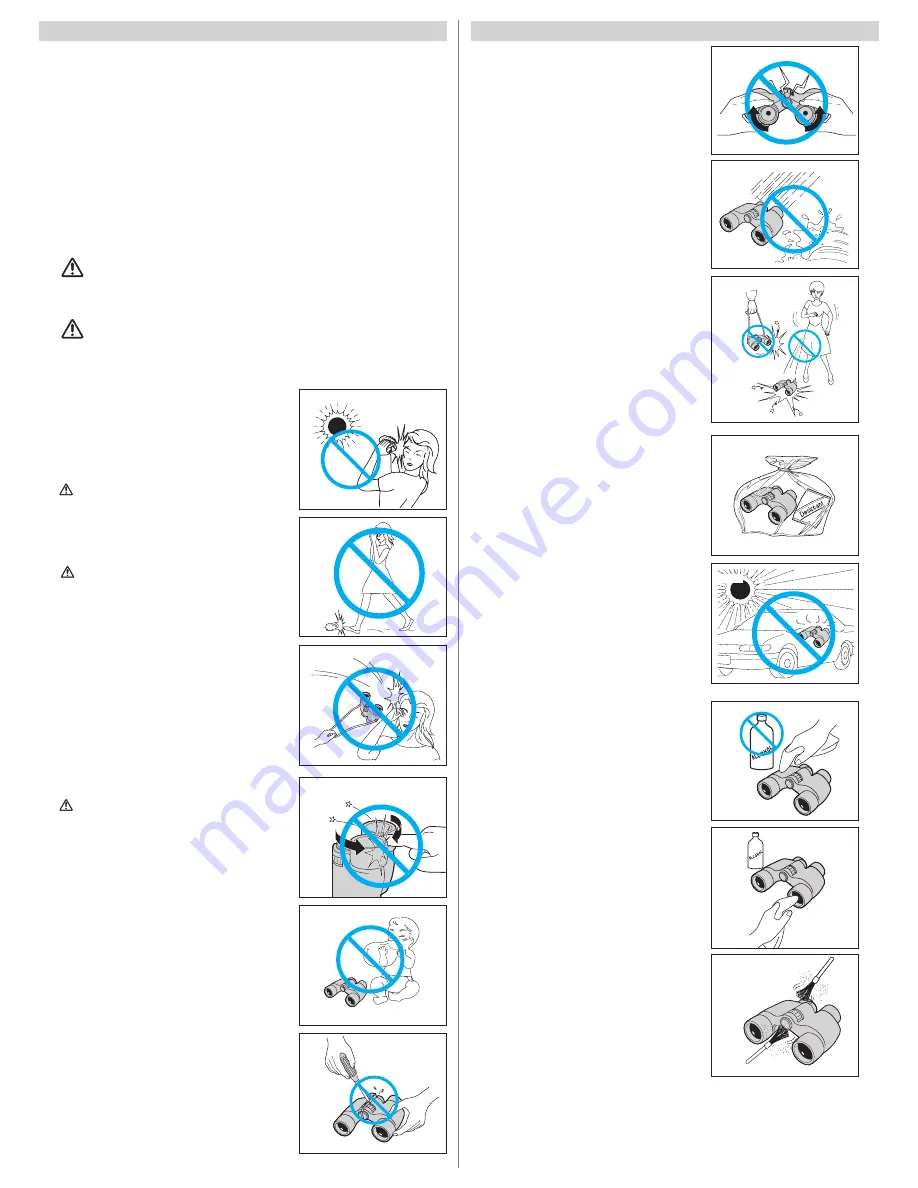
Thank you for purchasing the Nikon binoculars.
Strictly observe the following guidelines in order to use the
equipment properly and avoid potentially dangerous accidents
1 Before using the product, thoroughly read the “SAFETY PRECAUTIONS”
and the instructions accompanying the product on correct use.
2 Keep these instructions within easy reach for reference.
3 Some of the “SAFETY PRECAUTIONS”, “OPERATION PRECAUTIONS”
and “OPERATION” described here may not refer to the product you
purchased.
In order to protect you and third parties from possible injury and/or property
damage or loss, you are kindly requested to pay close attention to all
instructions, warnings and cautions regarding the use and care of this
product.
Precautions
OPERATION PRECAUTIONS
The items contained in this section alert you
to the fact that any improper use ignoring the
contents described herein may negatively
affect product performance and functionality.
WARNING
This indication alerts you to the fact that any improper use ignoring the
contents described herein can result in potential death or serious injury.
CAUTION
This indication alerts you to the fact that any improper use ignoring the
contents described herein can result in potential injury or may cause only a
material loss.
Never look at the sun directly while using
binoculars.
Doing so may seriously damage the eyes.
(Fig. 1)
CAUTION
!
• Do not leave the binoculars in an unstable
place. They may fall and cause injury.
• Do not look through the binoculars while
walking. You may walk into something and
get hurt. (Fig. 2)
• Do not swing the binoculars by their straps.
They may hit someone and cause injury.
(Fig. 3)
• The soft case, strap, and external materials
utilized on binoculars and rubber eyecups
may deteriorate due to aging and stain
clothes. To prevent this, check their
condition before each use, and consult with
the shop where you bought them if such
deterioration is found.
WARNING!
Fig. 1
Fig. 2
Fig. 3
• If you use the rubber eyecups for a
long period of time, you may suffer skin
inflammation. If you develop any symptoms,
consult a doctor immediately.
• Be careful not to pinch your finger when
adjusting interpupillary distance or diopter.
Be particularly careful if you let small
children use the binoculars. (Fig. 4)
• Do not leave the polyethylene bag used
for packaging within small children’s reach.
Children may put it on their mouths and
suffocate.
(Fig. 5)
• Be careful that small children do not
inadvertently swallow the cap or eyecup.
If it does happen, consult a doctor
immediately.
• Do not disassemble the binoculars. Repairs
should only be performed by a trained
engineer.
(Fig. 6)
CAUTION
!
Fig. 4
Fig. 5
Fig. 6
OPERATION AND CONTROLS
1. Do not open the right and left binocular
tubes beyond their limits. Also be careful
not to rotate the diopter ring, focusing ring
beyond their limits. (Fig. 7)
2. Avoid rain, water splashes, sand and
mud. (Fig. 8) With waterproof binoculars,
though some rain or splashed water will
do no harm, wipe the water off as soon as
possible.
3. Always protect binoculars from shock. If
you cannot obtain a normal image after
dropping or getting the binoculars wet,
take them immediately to the shop where
you purchased them.
(Fig. 9)
4. When exposed to sudden temperature
changes, water condensation may occur
on lens surfaces. In this case, thoroughly
dry the binoculars at room temperature.
Fig.7
Fig.9
Fig.8
STORAGE
5. Water condensation or mold may occur on
lens surfaces because of high humidity.
Therefore, store the binoculars in a cool,
dry place. After use on a rainy day or
at night, thoroughly dry them at room
temperature, then store in a cool, dry
place.
6. For lengthy storage, keep binoculars in a
plastic bag or an airtight container with a
desiccant. If this is not possible, store in a
clean, well-ventilated place, separate from
the case, as they are easily affected by
moisture. (Fig. 10)
7. Do not leave the binoculars in a car
on a hot or sunny day, or near heat
generating equipment. This may damage
or negatively affect them.
(Fig. 11)
Operation Precautions
Fig.10
Fig.11
MAINTENANCE & STORAGE
8. After having removed dust with a blower,
clean the body surface using a soft, clean
cloth. After use at the seaside, lightly
soak a soft, clean cloth with water and
wipe off salt that may be on the body
surface. Then wipe the body surface with
a dry cloth. Do not use benzene, thinner,
or other organic agents. (Fig. 12)
9. When removing dust on the lens surface,
use a soft oil-free brush.
10. When removing stains or smudges like
fingerprints, from the lens surfaces, wipe
the lenses very gently with a soft clean
cotton cloth or quality oil-free lens tissue.
Use a small quantity of pure alcohol (not
denatured) to wipe stubborn smudges.
Do not use velvet cloth or ordinary tissue,
as it may scratch the lens surface. Once
the cloth has been used for cleaning the
body, it should not be used again for the
lens surface. (Fig. 13)
11. Remove dust trapped in the focusing unit,
diopter adjustment unit, or other rotating
parts with a soft brush.
(Fig. 14)
Fig.12
Fig.13
Fig.14
Printed in China (204K/1E)




